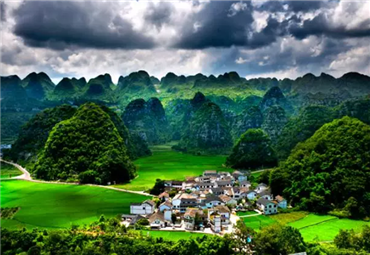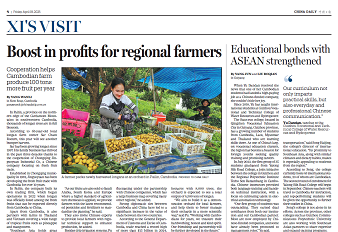New Guizhou projects bridge valleys, changing lives

An aerial photo shows the Zangke River Bridge in the Wumengshan National Geological Park, Guizhou province. [Photo provided to chinadaily.com.cn]
Tang Qiguo and his two colleagues enjoy the kind of breathtaking views from their workplace that probably beat the views from 99 percent of company headquarter offices anywhere in the world.
They work with the clouds beneath their feet, and fog at their fingertips and looking down, their view is of a river flowing through a valley, surrounded by mountains.
The three men are construction workers on the Zangke River Bridge, one of the most important projects along a new freeway linking Nayong and Qinglong in Guizhou province.
It is like a massive swing hanging between the mountains, high above the river. The 21-year-old and his peers work on cables strung at a height of some 200 meters, the equivalent of about 88 stories in height. To do so, they use two special walkways that run for around 1,000 m on either side.
The walkways are made out of wooden planks and metal grids and are fenced in. Although both the engineers and construction workers have said they are quite safe, it takes someone able to conquer their fear to walk them.
This isn't a problem for Tang or his colleagues, who traverse the walkways as easily as if they were walking along the street, albeit one at a height of over 200 m.
Construction is expected to be completed in August, 2024. Once finished, the bridge will slash travel time across the valley from 1 hour to 1 minute, greatly benefiting the residents of the mountainous area.
It's a reflection of the ambitions for the development of transport in Guizhou, which is a mountainous province with little flat land.
As a result of these difficulties, Guizhou's development has been subject to restriction and it was once one of the poorest provinces in China.
Compared to the plains, transport through Guizhou's mountains requires advanced technological solutions and costs more to build, requiring many tunnels and bridges.
According to the provincial transport commission, there are more than 28,000 bridges dotted along the region's 210,000-kilometer road network, 8,331 km of which are freeways. In 1949 when the PRC was founded, there were just 357 bridges in Guizhou.
They are not only a link enabling social and economic development, but also a "calling card" that demonstrates major Chinese accomplishments in transportation infrastructure.

A photo shows the Zangke River Bridge in the Wumengshan National Geological Park, Guizhou province. [Photo provided to chinadaily.com.cn]
Home to award-winning bridges
Guizhou is home to all four types of bridges; suspension cable, cable-stayed, arched and beam.
"There are around 28,000 bridges on roads in Guizhou. Linked together, they would extend more than 5,400 km, further than the distance of a round trip between Beijing and Guiyang, the provincial capital, and long enough to run across the Chinese mainland," said Xu Xianghua, chief engineer at the Guizhou transport commission.
By the end of last year, nearly half of the world's 100 tallest bridges, and four of its 10 tallest bridges, were in Guizhou. Fifteen have won 25 domestic and international awards. Four have won the Gustav Lindenthal Medal, one of the most prestigious bridge construction awards in the world, a prize only five other bridges in China have won.

A photo shows the Zangke River Bridge in the Wumengshan National Geological Park, Guizhou province. [Photo provided to chinadaily.com.cn]
Advanced technology and innovation
The 1,849-meter-long Zangke River Bridge is located in the Wumengshan National Geological Park and spans the Zangke River.
"It is a double-tower, single-span steel truss suspension bridge. The highest drop between the bridge deck and the river is 380 meters. Upon completion, it will be the 11th of the world's 100 tallest bridges," said Zhao Mingfu, the engineer leading construction.
The bridge crosses the meeting point of four counties and districts – Qinglong, Pu'an, Shuicheng and Liuzhi – and will benefit residents in all those places, as well as boost economic development, Zhao added.
Engineers devised five technological innovations and 10 management innovations to ensure safety during construction, Zhao said.
For example, they use a special alloy on the sealed rope sling, which prevents substances like dust and rust from entering the interior of the sling. They have also made use of new materials to make the cable, which has superior resistance against corrosion.
The team is focused on safety. Workers are encouraged to take quizzes on safety issues online by scanning a code posted at the construction site. By answering the questions, they earn points which can be used to buy supplies and snacks on the site.
"It is an innovative way of encouraging worker to pay attention to safety issues. They can also report safety issues to earn points," said Ran Maolun, general manager of the Guizhou Naqing Freeway Corp, which is building the freeway linking Nayong and Qinglong.
Another one of the freeway's bridges, about half an hour's drive from the Zangke River Bridge, is also under construction.
The Wumengshan Bridge crosses the Azhi River and is designed using a unique form of arched bridge.
"Due to the complicated geography and terrain, it is the first bridge in the world to use such a structure," said Liu Xiaofan, the engineer leading construction of the bridge.

A photo shows the Wumengshan River Bridge in the Wumengshan National Geological Park, Guizhou province. [Photo provided to chinadaily.com.cn]
"The design will help reduce the weight of the bridge. Compared with other concrete arch bridges, it will also greatly save on the amount of concrete used," he said.
As the bridge is located in the Wumengshan National Geological Park, designers tried hard to reduce its impact on the environment.
"During construction, we are following a terraced shape with the aim of reducing the amount of excavation needed," Liu said.
Usually, the temporary anchorages on both sides of a bridge are dismantled after completion. In this case, instead of dismantling the anchorages, engineers have envisaged their long-term use, he said.
Other advanced concepts of green construction are also being applied to the project.
A worker's dream comes true
The bridges will link the mountainous province to the rest of the country, fulfilling the dream of generations of construction workers to make Guizhou easier to reach by road.
Shen Xiuqiao, a Guizhou native, is a construction worker on the Zangke River Bridge. His father, who also worked on roads and bridges, named his son Xiuqiao because it means "building bridges" in Chinese.
"I've been building roads and bridges for over 20 years. I'm very excited to see more and more bridges being built here," he said, adding that he is also proud of his father and grandfather, both of whom also built roads and bridges and tried to make Guizhou a better and more easily accessible place.
All rights Reserved. 京ICP备13028878号-8







 Overview
Overview Guiyang
Guiyang Guian New Area
Guian New Area Liupanshui
Liupanshui Anshun
Anshun Qianxinan
Qianxinan Qiandongnan
Qiandongnan Qiannan
Qiannan Zunyi
Zunyi Tongren
Tongren Bijie
Bijie Guizhou commits to culture preservation and rural vitalization
Guizhou commits to culture preservation and rural vitalization Guizhou voice at 2025 national two sessions
Guizhou voice at 2025 national two sessions Meet the 'genius moms' at Shenzhen cultural fair
Meet the 'genius moms' at Shenzhen cultural fair 

